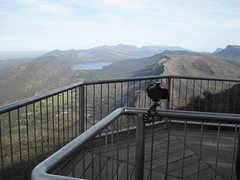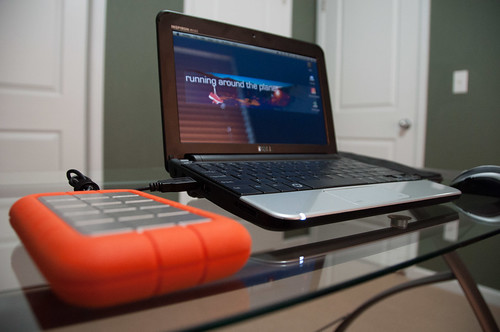camera: Nikon D90 - a prosumer DSLR. DSLRs have their advantages and disadvantages. This camera with lens is sometimes a bear to carry around, it can't slip into your pocket and sometimes it's a little big to get those 'discrete' shots. Luckily Abby has a small Canon point and shoot that can fill those gaps. On the plus side it has about all the functions you could ask for in a camera in this price range and I'm consistently able to get the shots I want.
lens: Nikon 18-200 f:3.5-5.6 - this is basically the swiss army knife of lenses, it allows for good wide angle shots, think mountain landscapes, and also has a good telephoto for getting in close. I chose this lens so I wouldn't have to deal with carrying around multiple lenses or having to change lenses in difficult situations, like hiking or on a cramped bus. Basically it's not the best lens, but it does a lot of things well.
accessories:
- Joby Gorillapod SLR-Zoom Tripod, it's been great for night shots or photos of Abby and me when no one is around
- Dawn Tech di-GPS Mini 3L, basically a little gadget that attaches to the camera so photos are tagged with the location of the shot (GPS coordinates). It has been a lot of fun being able to see the exact spot a shot was taken, Here is link of all my photos on a map.
- SD cards, about 30 GB worth, basically I can shoot over 1500 photos before needing to download to a computer.
- Tiffen 72mm Polarizing filter, basically polarized sunglasses for your camera, helpful in getting getting dark blue skies and shots of water
- spare camera battery, you don't know when you're not going to have a place to charge your battery

The above things help get the shot, but after that comes the post processing of the images. I shoot in RAW, which basically means the camera is taking a digital negative and once it's on the computer I have a lot more control of getting the photo to look how I want, similar to the film days when you would head into the darkroom. So along with the camera gear, we have a laptop for processing, uploading and backing up photos.

computer: Dell Inspiron Mini 10v - your standard 10" netbook, but it's running Mac OS X, that's another blog post in itself.
accessories:
- LaCie 500GB Rugged HDD, this hard drive was a big must have for me, since we were going to be gone for an extended period of time I needed a way of knowing that all of our photos would be safe so this hard drive is used for backups, which I'll cover in more detail later. This hard drive also touts being a little more durable than others and is supposed to be able to withstand a drop, so just in case...
- wireless mouse, cables, etc.
One of the challenges of planning what to bring is how much hard drive and memory card space we'd need to house and then backup all of the photos. As a starting point I looked back at several of the extended trips we'd taken (Peru, France & New Zealand) to calculate that I had taken on average 91 photos/day, which based on this trip at 7 months would be a total of almost 20,000 photos and over 200 GB of space.
So with that as a starting point and factoring in Abby's photos as well as documents, some movies and whatever else we had on the laptop I decided to upgrade the hard drive in the laptop to 500 GB and purchase a 500 GB backup hard drive. I also purchased a several 8 GB SD memory cards so that if we were without the laptop for a few weeks I could keep shooting.
Now all we have to do is lug this stuff around and make sure it doesn't get broken, which we've been successful at so far.
For more info on the other aspects of my workflow, check the main post for links: Photography Workflow

No comments:
Post a Comment